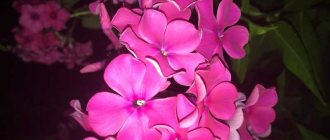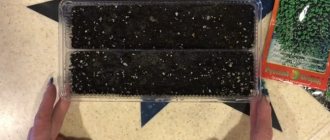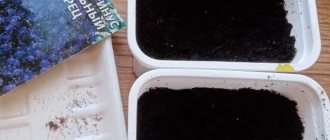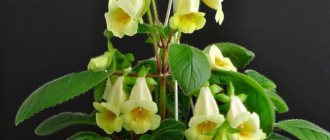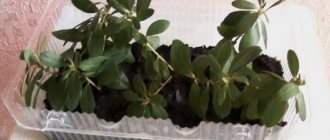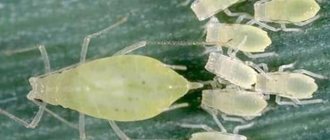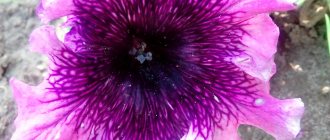Annual phlox flower - description
The vast majority of phlox are perennial herbaceous plants, the tops of which are decorated with small flowers collected in corymbose-shaped bunches. By cold weather, the above-ground stems of perennial phlox die off, and the roots overwinter in open ground, sprinkled with leaves and snow. In spring, new shoots sprout from the roots of perennials.
phloxes in the flowerbed
Annual phloxes need to be regrown every year. This is done through seedlings or by sowing seeds directly into the ground. Phlox seedlings turn into branched, lush, low-growing shrubs with colorful, dense inflorescences.
The size of phloxes and the intensity of their color depend on the growing conditions - mini phlox varieties with abundant watering and fertilizing, sufficient lighting can grow up to 1.0 m and be very bright; under normal conditions, these phloxes will not grow higher than 30 cm.
Drummond phlox in the flower garden
Interesting varieties
Cultivated varieties differ in plant height, color, and flower shape.
Regarding the shape of the petals, phloxes are divided into 2 subspecies:
|
|
New groups and individual varieties are constantly appearing in the world. They all reproduce from seeds.
Some interesting varieties of phlox are presented below:
- “Carnival” Carnival is a variety with multi-colored flowers with darker eyes.
- "Grandiflora" Grandiflora - produces large white-purple flowers, 40 cm high.
- “Allure” is a variety 40 cm high, branches well, blooms all summer until October, the flowers are soft pink with a dark center.
- “Beauty in Yellow” is a beautiful variety with delicate yellow flowers, up to 25 cm high, suitable for growing in containers.
- "Nana Compacta Beauty" Nana Compacta Beauty - grows up to 20 cm, blooms with pink or red flowers, less often white.
- “Ethni Salmon” is a dwarf variety up to 15 cm high, the flowers of the plant are very delicate peach-pink, the center is pink.
- "Stelaris Twinkle" Stelaris Twinkle is a low variety with multi-colored flowers.
- "Twinkle Star" Twinkle Star - purple with long petals, blooms all summer from June to September, has lanceolate green leaves and highly branched pubescent shoots, 40 cm high.
The most important are dwarf varieties, with a compact shape, 15-20 cm in height. Valuable varieties include varieties from the groups “Crystal”, “Palona”, “Dolly” and “Hercules” F1, with a wide range of colors, readily grown in multi-color mixtures. Varieties from the newest groups grow a little higher: “21st century” F1 and “Etni” F2. Dwarf varieties are very valuable plants for planting in various types of containers and balcony boxes. They are also suitable for flower beds, planted on the edges of ridges.
Reproduction of annuals
Annual phloxes reproduce by seeds. It was once believed that planting and caring for annual phlox was a very difficult task that did not always end successfully. Not everyone was able to see phlox sprout.
Phlox: planting and care in open ground
But then we noticed that sometimes in the spring self-sowing seedlings appear, the seeds of which fell to the surface of the soil in the fall and no one covered them with soil. And if rain and melted snow did not wash these seeds into the holes, they sprouted successfully.
Important! Phlox seeds require sunlight to germinate.
Phloxes are propagated in two ways. In southern regions and areas of mild temperate climates, seeds are sown directly on the soil surface. In areas with harsh winters, in the mountainous regions of the Urals and Siberia, seedlings are first grown. Annual phloxes, seedlings of which were grown from freshly harvested seeds, will be resistant to diseases and pests.
Necessary conditions for growing seeds
In order to successfully grow annual phlox, you need to follow several rules:
- For sowing, only large seeds from fully ripened seed pods are selected;
- to obtain large seeds on mother plants, several stems with inflorescences and stepsons are removed, half of the buds are left in the inflorescences;
- Healthy, well-developed bushes are used as a mother plant; they are intensively fed and watered.
Additional information: if the seeds do not have time to fully ripen in the seed pods before the onset of cold weather, the branches with pods are cut off, tied into bunches, placed in a gauze bag and left to dry completely in a ventilated area at room temperature.
To form a spherical bush and form numerous side shoots, phloxes begin to be pinched at the seedling stage. After the 5th leaf appears, the top of the central stem is either cut off or pinched by hand.
Preparing seeds for sowing
Dried boxes with Drummond phlox seeds are stored in a cold place - the basement, the vegetable compartment of the refrigerator. Seeds are not removed from the boxes until they are sown. This is due to the fact that the seeds quickly dry out in the air and lose their viability.
A few days before sowing, the seeds are poured out of the testes and soaked in a pink solution of potassium permanganate for 10-15 minutes. The floating seeds are discarded, the rest are washed in running water. Then they are dried, spread on a paper towel, and planted in a nursery.
Seeds
How to sow seeds for seedlings
Phlox seeds take a long time to germinate - up to 3-4 weeks. Therefore, seeds for seedlings are sown in early to mid-March. Placement boxes must have sides at least 5 cm high and drainage holes. Moistened soil substrate is poured to 3/4 of the height of the box. The soil surface is compacted with the back of a tablespoon or scoop.
Using a damp toothpick, seeds are distributed over the surface of the soil in rows at intervals of 3-5 cm and lightly sprinkled with a thin layer of sand. Sowing can also be indiscriminate - for this, the seeds are mixed with sand and scattered around the box as desired.
Mini-greenhouse conditions are created in the boxes: they are covered with glass or transparent plastic. Periodically check for signs of mold and pests, ventilate and moisten.
Note! Seeds can be sown immediately in individual volumetric containers, in which case there is no need to pick seedlings.
What does phlox seedlings look like?
After the seeds hatch, it will take at least 2-3 weeks for 2 pairs of true leaves to grow.
At this time, the plants are planted - transplanted into larger boxes; a distance of 8-10 cm is maintained between the bushes.
In three months, the plants will already have 5-6 pairs of leaves and the first buds.
Young seedlings
Phlox seeds for seedlings. Growing seeds for seedlings
Annual and perennial phloxes, the planting of which with seeds is quite common, germinate well if they are not deeply buried in the soil. This should definitely be kept in mind, since otherwise the seeds may not germinate or you will have to wait quite a long time for germination, two to three weeks, and they will not be friendly (with surface sowing, seeds usually germinate after 7 days). The easiest way is this: the seeds are scattered over the surface of the soil in plastic containers, watered from a sprayer and covered with a transparent film on top. This is usually done in March. Holes must be made at the bottom of the containers to prevent stagnation of water from being harmful to the seeds. It is better to use special soil for seedlings. Its layer should not be too deep. It is advisable to spill it with a weak solution of potassium permanganate five days before planting, and pre-water it with a solution of phytosporin the day before planting. Seeds should be ventilated daily by opening them and shaking off condensation from the film.
After the appearance of two leaves, the sprouts dive. Seedlings, as a rule, tolerate picking normally. It is only recommended to protect them from direct sunlight in the first two to three days to avoid burns to the tender leaves. Flower growers recommend covering the top of the seedlings with newspapers or opaque film. Phlox grown from seeds for seedlings are planted in the ground at the end of May, best at a distance of at least 20 cm from each other. It will be useful to mulch the soil between young plants to better retain moisture. Periodically, once a month, they should be fed with complex mineral fertilizer. In addition, further care, as in the case of other garden flowers, involves loosening, weeding and regular watering.
Annual phloxes can be sown with seeds in the spring and directly into the ground, but with this method their germination rate will be low. In addition, it should be borne in mind that they bloom only two months after planting. Therefore, growing from seeds to seedlings is preferable in this case.
Rules for caring for seedlings
The containers in which the seeds are sown are kept at room temperature no higher than +25°C. After the seedlings appear, the boxes with them should be exposed to light for at least 12 hours a day.
Perennial phloxes: planting and care in open ground
If the seedlings begin to stretch, then reduce the ambient temperature to +15+18°C and lengthen the daylight hours to 14-15 hours. Lamps are used to artificially illuminate seedlings.
The soil in the seedling boxes is kept constantly moist. Avoid excessive watering, otherwise the roots may rot. Before planting in the flower garden, plants are fed with nitroammophoska or other complex preparations.
Attention! Phlox after transplanting into open ground will hurt for the first two weeks.
Unlike plants that grow from seeds immediately in a flower garden, the tips of the root shoots of seedlings suffer even with the most careful handling. Therefore, it is during this period that transplanted plants require timely watering.
Adult seedlings
How to replant
Perennial flowers have good survival rate. Therefore, if the initially selected area is not suitable for phloxes or they have stayed in one place for a long time, you can fearlessly move them to another flowerbed. Transplantation is usually carried out in late summer or early autumn. During this period, on the one hand, the plant slows down its life processes, and on the other, it has enough time to take root.
Flower growers usually do not have questions about how to replant phlox. The same procedure is carried out as during landing. But you should not overuse fertilizers, especially nitrogen ones. It is better to add potassium and phosphorus, they help the plant quickly adapt to a new place and prepare for wintering.
Annual phloxes: care features
- Choosing a site for planting, soil
Perennials and annuals require the same growing conditions - nutritious loose soil with neutral acidity, moderate occurrence of soil water, a plot of land well protected from the wind, and plenty of light.
- Flower care during and after flowering
Phlox spread blue: planting and care
A well-established flower grows a stem and increases the number of leaves, producing many inflorescences that form a dense bunch. Plants need good nutrition, which comes through the roots along with moisture.
Watering is carried out as the soil dries. Do not allow the formation of a surface soil crust - carry out regular, careful loosening.
Make sure that there are no weeds in the root zone and near the plants; they constantly pick off wilted, dried flowers along with their stems.
- Preparing for winter
Attention! In autumn, the seed boxes are cut off from the mother plants, the stems and rhizomes are removed, the soil is dug up and work is carried out to increase the fertility of the flower garden.
Phlox subulate from seeds. Phlox subulate: planting and care in open ground
Not everyone likes to tinker in the ground, dig potatoes, grow dill and parsley. But everyone wants their backyard to look presentable. One of the best options is to seed everything with grass or cover everything with artificial grass. But this is quite expensive and troublesome. There is another way - to plant the area with a low semi-shrub creeping along the ground, which received the scientific name phlox subulate.
Botanical description of the plant
Phlox subulate is a perennial ground cover shrub. Botany classifies it as a member of the Sinyukhov family, and from a distance it looks like a blooming lilac creeping along the ground.
Phlox subulate
The main characteristics are as follows:
- Depending on the variety, phlox can be either 5 cm in height or 17 cm, but no more.
- The stems do not tend to the heights at all. They consist of many branches, some of which go back into the ground and put down additional roots there. The maximum length of one branch is 50 cm. The color of the stems is green, and the maximum thickness is up to a centimeter.
- The leaves on the stems are located quite tightly to each other, thereby creating a thick “carpet”. The shape of the leaves resembles an awl, which is reflected in the name of the plant. The leaves are narrow, hard, opposite and rarely grow more than 2 cm.
- The plant's roots go deep to a maximum of 15 cm. But it has many appendages, which allows the phlox to receive the required amount of minerals.
- The most important thing is flowers. In fact, they are small, but thanks to their large number they create a beautiful picture. Each flower is no more than 2-2.5 cm in diameter. Consists of 5 petals forming a flat corolla. There are different colors: white, cream, pink, purple and blue shades.
How to feed phlox for abundant flowering
During the entire flowering period, it is necessary to carry out 3 nitrogen mineral fertilizing, alternating with organic fertilizers - aqueous extracts of ash, chicken droppings containing potassium and calcium, and herbal infusion.
The first nitrogen fertilizing is carried out before planting seedlings in the flower garden. Then the condition of the plants is observed. Signs of a lack of nutrition will be yellowing of the leaves, inhibited growth of stems, and a decrease in the size of flowers.
Why don't perennial phlox bloom?
Perennial or annual phloxes will not be able to bloom if they grow in dense shade.
Their stems will become thinner and elongated. The plant will devote all its strength to getting to the sun, because without it the processes of photosynthesis will not take place, and there will be no strength left for flowering.
In addition, planting and caring for annual and perennial phlox should ensure that the plants do not suffer from a lack or excess of moisture and nutrients, do not get sick and are not attacked by pests.
Use in garden design
This annual blooms extremely richly and for a long time, with a whole scattering of fragrant flowers.
It is not afraid of the first autumn frosts until they reach a temperature below -5°C. The use of the plant is varied - in borders along paths, in flower beds, where it is combined with sparkling salvia, petunias and other crops. In containers and balcony boxes, Drummond's phlox, hanging slightly, forms bright caps of inflorescences. Gets along well with other container plants in ampelous compositions.
Also suitable for cutting, adding a wonderful aroma and rustic flavor to summer bouquets.
What to plant next to phlox
The various varieties of Drummond complement each other well.
Phlox star rain
For example, the colorful colors of the Star Rain variety allow you to create compositions only from plants of this species.
But still, if you plant chrysanthemums, delphiniums, aquilegias and double Drummond phlox nearby, the flower garden will become a decoration for any garden plot or flower bed in a park area.
This is interesting: when planting these plants, gardeners often use the recommendations of the lunar calendar so as not to miss the most favorable dates for planting seedlings.
Description of the species
There are only a few types of annual phlox, and only one of them has become popular - Drummond phlox. The homeland of this species is hot Texas, but the annual thrives in the continental climate of Europe and Russia.
Characteristics of Phlox Drummond:
- plant of small or medium height - from 12 to 30 cm;
- There are subshrub varieties that can grow up to 150 cm in the sun;
- the stems of the flower are highly branched and herbaceous;
- the leaves are small, arranged oppositely, and have an oval-lanceolate shape;
- inflorescences are small but abundant;
- the shape of the petals can be different: needle-shaped, star-shaped, round;
- the color of annual phloxes is also varied (from white to salmon and blue);
- the structure of the flower can be either simple or double;
- annual phlox exude a strong sweet aroma;
- flowers are suitable for decorating flower beds, borders, ridges, they can be planted in boxes and flowerpots.
Attention! An interesting feature of annual phlox is their sensitivity to light: in the sun the flowers become brighter, while in the shade or cloudy weather their color fades.
It has been noticed that the same varieties of annual phlox can have different heights depending on the planting location. So, on highlands, spherical bushes grow to a maximum of 25-30 cm, while on the sunny plain plants can stretch more than a meter.
Pests and diseases - how to deal with them
Modern experienced gardeners know that various herbal decoctions and folk remedies can repel pests and slow down the development of diseases. But only professional methods based on chemical and biological preparations will help destroy insects and cure diseases.
Yellow phlox
- Snails and slugs. Loosen the soil in a timely manner, sprinkle the paths near the phlox with ash, collect by hand and destroy.
- Nematodes. No high-quality protective measures have been invented - it is better to pull out and destroy the affected plants, preventing the spread of the pest.
- Scoops. Collect caterpillars by hand. In case of severe damage, use insecticides.
- Penny is slobbering. Remove damaged leaves and treat with garlic infusion.
- Green wood bug. Spray phlox with onion infusion.
- Cruciferous flea beetles. Dust phloxes with wood ash in the morning.
Control measures depend on the specific disease or pest.
Growing annual flowers requires additional time associated with sowing seeds and planting seedlings. But even if a gardener has to take time away from household chores in order to plant and care for plants throughout the summer season, he will do it without hesitation. After all, beauty is worth it.
What does Drummond's phlox look like?
This flower is the only exception among its “relatives”. Unlike them, it is an annual plant. But this feature does not affect the abundance of flowering and decorativeness of the crop.
In nature, it was most widespread in North America, especially in the southern states along the border with Mexico. Now “wild” varieties are extremely rare.
“Natural” Drummond phloxes are very rare in garden plots, almost never
The bushes are not tall (about 50 cm), but they are distinguished by an intensity of branching that is unusual for a crop. Plants, reproducing by self-sowing, form entire continuous “carpets” due to the splendor and numerous inflorescences. The leaves are narrow and elongated, lanceolate. They are located opposite on the stem.
The leaves of Drummond phlox are quite narrow and elongated.
It blooms profusely and for a long time. If it is grown by seedlings, the buds open already in June, when sowing seeds in open ground - about a month later. In bright sunshine, the color of the petals does not fade. The plant retains its decorative properties until the first frost. It can survive temperatures as low as -5°C. In this case, the buds, of course, will suffer, but the leaves and stems will not, so the plant will quickly recover.
Drummond phlox bushes are not tall, but this does not affect the abundance of flowering.
The color range is very wide. The color of the petals varies from snow-white to dark cherry, including all sorts of shades of pink and red. Also, Drummond phloxes can be blue, blue, lilac, violet. The only exception is yellow. Such phloxes do not exist in nature, and breeders have not yet been able to achieve this shade. But varieties have been bred with two-color petals and “patterns” on them, as well as terry ones. In addition to the “classic” round shape, the petals can be pointed, narrow, as if “cut” along the edges, with a needle-like tip.
Individual achievements of breeders bear very little resemblance to Drummond’s “wild” phloxes
Inflorescences in the shape of a shield or umbrella. Individually, the flowers are quite small (on average 20–25 mm), but the diameter of the entire inflorescence reaches 12–15 cm. The lifespan of each bud is short (7–8 days), new ones are constantly opening.
Even non-double varieties of Drummond phlox look very pretty
Culture is widely used in landscape design. Low-growing varieties are ideal for decorating borders; they are also planted in hanging pots and containers, and decorative flowerpots. The plant also looks good in group compositions, especially with tulips, daffodils and other bulbous plants that do not differ in flowering time. Also suitable “companions” are bluebells, matthiola, bindweed, snapdragon, decorative flax, echinacea, and catnip. Drummond phloxes are often planted in rock gardens and multi-tiered flower beds. You can also create a multi-colored “carpet”. This flowerbed looks especially impressive if you combine several shades with each other.
Drummond phloxes look very impressive, covering a large area with a continuous carpet
In addition to the general decorativeness and duration of flowering, Drummond phlox has a number of other undeniable advantages - low maintenance, good immunity (the plant rarely suffers from diseases and is subject to attacks by pests), drought and cold resistance, the ability to plant seeds in open ground and for seedlings, easy propagation self-seeding.
Drummond's phloxes in the flowerbed go well with any low-growing plants
Phlox variety Twinkling star for summer residents
- How phlox is grown in the country
- How to care for phloxes in the country
How can the twinkling star phlox variety be interesting? In general, this flower is now represented by more than 400 varieties. Growing the plant is quite simple.
How phlox is grown in the country
The differences between phlox varieties are very simple. If we talk about the Twinkling Star, then it is very easy to recognize it. These star-shaped flowers also have a characteristic, fragrant aroma. There is no fundamental difference in cultivation. But the petals of the plant seem to be pointed. It `s very unusual. They are not round, like the classic varieties. These bushes are also very low. They are unlikely to grow above 35 cm in height. It is valued for its dense, bright inflorescences; their diameter can reach 10 cm.
Growing conditions
Drummonda flowers will delight the gardener for a long time if you choose the right planting location. The plant tolerates drought conditions well and loves the sun, so shaded areas are not suitable for growing.
The annual plant is not afraid of the first frosts. The stems remain green; low temperatures only affect the flowers. Thus, Drummonda blooms before the first night frosts in mid-autumn.
The soil should be moderately enriched with peat, humus, and humus. Deviations in one direction or another can harm phloxes.
If the soil is too heavy, the plant will begin to rot due to excess moisture. In light soil, Drummonda's roots will be susceptible to overheating.
Phlox variety Twinkling star for summer residents
Flowers – Phlox variety Twinkling Star for summer residents
Phlox variety Twinkling star for summer residents - Flowers
How can the twinkling star phlox variety be interesting? In general, this flower is now represented by more than 400 varieties. Growing the plant is quite simple.
How phlox is grown in the country
The differences between phlox varieties are very simple. If we talk about the Twinkling Star, then it is very easy to recognize it. These star-shaped flowers also have a characteristic, fragrant aroma. There is no fundamental difference in cultivation. But the petals of the plant seem to be pointed. It `s very unusual. They are not round, like the classic varieties. These bushes are also very low. They are unlikely to grow above 35 cm in height. It is valued for its dense, bright inflorescences; their diameter can reach 10 cm.
The agricultural technology of the Twinkling Star is characteristic. The plant has a stage of greatest decorativeness. It is achieved by providing moderately moist, fertile soil in a sunny place.
When seedlings are grown, sowing is carried out in the month of March, using seedling boxes. The seed placement depth parameter will be 0.5 cm. Maintaining a soil temperature of +18 °C, seedlings are expected to emerge on days 7-14. To maintain seedlings, moderate temperatures are needed. Seedlings should be planted in the ground at the end of May. It is necessary to maintain a distance of 20-25 cm. Seeds are sown in open areas in May. Before this, they are soaked for 20-30 hours. Let's take a closer look at the conditions in which phlox grows.
The main requirement is the possibility of generous watering. If there is a danger of prolonged drought, even the proximity of a pond and stream will not save the plant. Drying out the soil is contraindicated.
It is also important to choose the right soil. Phlox respond well not only to sunny places. Partial shade is also suitable for them. The best option is an area that is protected by trees and bushes. This creates excellent shading for the plants, even in hot weather. This is very important for varieties that are called brightly colored. And in winter, it is under the trees and bushes that snow settles. This makes it possible to reduce temperature fluctuations to a minimum. In winter this is very important.
- the choice should be made on an area where there is a slight slope. When snow melts or rainy seasons, this will save the plants from flooding. There are also the following recommendations on how best to plant phlox in the garden:
- if the soil on the slopes dries quickly, it is unfavorable in this case;
- It is impossible for snow to be blown onto the plantings in winter, and water to flow down during rainy periods;
- An environment of trees whose roots grow from the top is not suitable, these include lilac and birch, etc.;
- Western, eastern, southwestern and southeastern slope positions are suitable for a flower garden;
- The north side, or the shade of coniferous trees, is worse.
